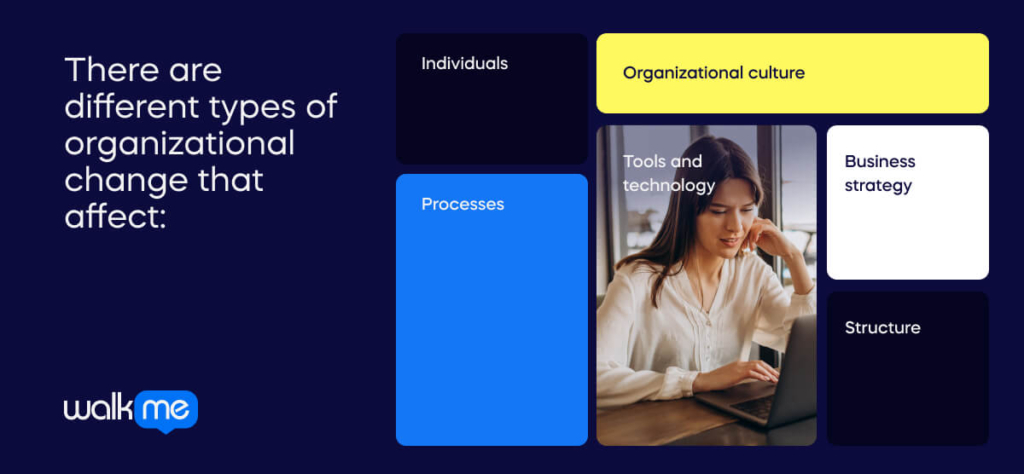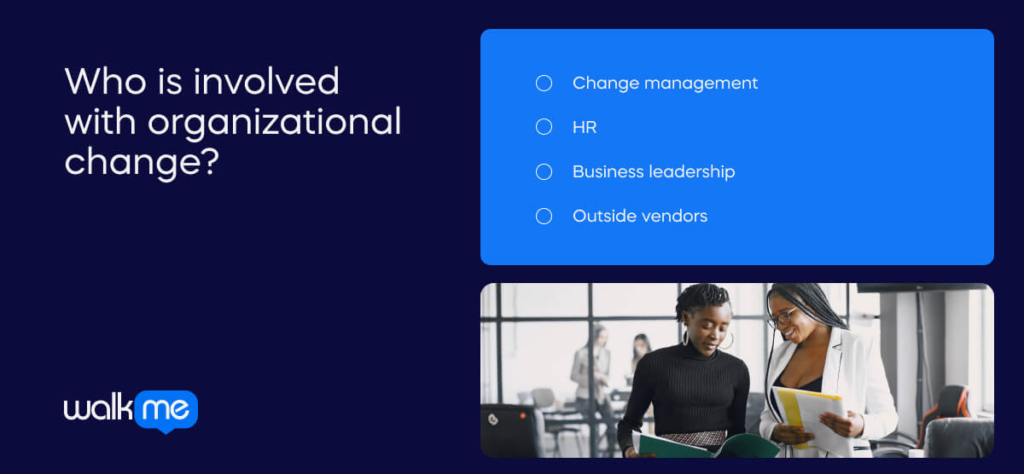This organizational change FAQ covers the basics of organizational change.
This guide is ideal for:
- Business professionals who need to implement organizational change
- HR professionals
- Students researching organizational change
- People who want a quick refresher on the subject of organizational change
- And anyone else who wants to learn about this essential business topic
Intermediate or advanced learners may want to browse the rest of our change management blog.
It contains a wide range of articles on change management, organizational change, the digital workplace, and more.
Organizational Change FAQ
Let’s look at 10 of the top questions on the topic of organizational change.
What is organizational change?
Organizational change refers to changes that take place within an organization.
There are different types of organizational change that affect:

- Individuals
- Organizational culture
- Processes
- Tools and technology
- Business strategy
- Structure
To name some of the most common examples.
Organizational changes can be large, small, or somewhere in the middle.
Also, a particular change project may include several types of change. A merger, for instance, can often encompass many changes, from cultural changes to workflow changes.
Who is involved with organizational change?

Organizational change is often handled by a cross-disciplinary team that includes:
- Change management
- HR
- Business leadership
- Outside vendors
As well as those being directly affected by the change project.
Prosci suggests using five separate roles to implement change:
- The change management resource / team
- Executives and senior managers
- Managers and supervisors
- The project team
- Project support functions
Not every business approaches change management delegation in this way.
But this list provides a good framework for understanding the roles in change management.
Why is organizational change important?
Organizational change, as a concept, helps change practitioners better understand business transformations.
There are different models and frameworks for understanding organizational change and change management.
Which model you use is often a matter of preference.
It is better to have some model than no model at all.
Understanding organizational change, in short, helps you:
- Understand the different types of organizational change
- Understand how changes impact employees, business practices, profit margins, customers, and stakeholders
- Learn how to approach change effectively
- Streamline organizational change projects
To name just a few things.
What are the benefits of managed organizational change?
Managed organizational change, or change management, doesn’t just offer benefits.
It’s essential.
Here are a few reasons why:
- Managed projects have a much greater chance of succeeding than unmanaged projects
- Change management improves project outcomes and ROI
- Negative impacts – to the business itself, people, processes, and so forth – are minimized
- Employees are more likely to have a positive experience – which will boost productivity, performance, and engagement
Change management is also an essential factor in mitigating risk and overcoming barriers to change.
What are barriers to organizational change?
Some of the biggest challenges include:
- Employee resistance
- Resistance from middle managers
- Technology constraints
- Budget constraints
- Organizational inertia
- Lack of executive support
- Inability to prove the ROI of a change project
As mentioned, overcoming such obstacles is a key function of change management.
How is organizational change implemented?
Change management is a business discipline dedicated to managing, executing, and optimizing change projects.
Here are a few processes that can illustrate how change management operates:
- Change frameworks break down organizational change into stages and provides action steps for executing and managing change
- Change managers use metrics and KPIs to ensure that change projects meet their objectives
- Effective communication strategies ensure that all stakeholders stay in sync
- Change managers also use the latest technology, such as digital adoption platforms and training platforms, to improve employee training and onboarding.
Change manager duties vary from business to business, but their goal remains the same: plan, manage, and execute change projects.
What are the drawbacks to organizational change?
The drawbacks to organizational change are similar to the drawbacks of other business projects:
- They require investment
- Investments carry risk
- Projects may be unsuccessful, either partially or totally
- Changes can have negative impacts on business functions, such as service delivery or the customer experience
As with any business endeavor, it is important to carefully weigh the risks and potential downsides against the rewards.
What are some best practices for organizational change?
People drive change.
For this reason, change managers should blend “soft” disciplines with “hard” disciplines.
For instance:
- A solid communication strategy helps maximize employee cooperation, while ensuring all parties stay aligned
- Data and analytics can improve organizational changes on a variety of fronts – from software usage analysis to predicting team synergies
- Leadership, from someone on the change team, is essential for mobilizing support and earning trust
To name just a few.
When should organizational change take place?
Unfortunately, there is no one-size-fits-all answer to this question.
A short answer would be: “when it’s necessary.”
But a more intriguing answer is that change is constant – especially in today’s volatile marketplace.
To stay competitive, organizations should rethink organizational change.
In a marketplace that is always moving, the company that stops moving won’t be able to compete.
Therefore, forward-looking businesses should evolve their change management capability.
Agile change management is a good first step, for instance.
Where can I go for further information?
There are plenty of excellent resources online, including:
- Change management blogs, such as this one
- The blogs of industry leaders, such as Prosci
- Change management association websites
And for those who want more, certifications, workshops, and courses are a good choice.

